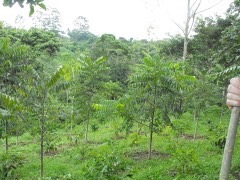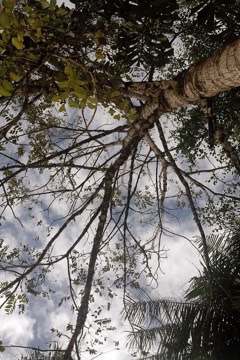 |
|
wikimedia.org |
 |
| wikimedia.org David J. Stang |
Translate this page:
Summary
Physical Characteristics

 Juglans olanchana is a deciduous Tree growing to 45 m (147ft) by 35 m (114ft) at a medium rate.
Juglans olanchana is a deciduous Tree growing to 45 m (147ft) by 35 m (114ft) at a medium rate.
See above for USDA hardiness. It is hardy to UK zone 10.
Suitable for: light (sandy), medium (loamy) and heavy (clay) soils. Suitable pH: mildly acid, neutral and basic (mildly alkaline) soils. It can grow in semi-shade (light woodland) or no shade. It prefers moist or wet soil.
UK Hardiness Map
US Hardiness Map
Synonyms
Juglans guatemalensis W.E.Manning
Plant Habitats
Edible Uses
Edible Parts: Seed
Edible Uses:
Seed - raw or cooked[331 ]. The shells are 34 - 45mm in diameter and 32 - 42mm long[595 ].
References More on Edible Uses
Medicinal Uses
Plants For A Future can not take any responsibility for any adverse effects from the use of plants. Always seek advice from a professional before using a plant medicinally.
None known
References More on Medicinal Uses
The Bookshop: Edible Plant Books
Our Latest books on Perennial Plants For Food Forests and Permaculture Gardens in paperback or digital formats.

Edible Tropical Plants
Food Forest Plants for Hotter Conditions: 250+ Plants For Tropical Food Forests & Permaculture Gardens.
More

Edible Temperate Plants
Plants for Your Food Forest: 500 Plants for Temperate Food Forests & Permaculture Gardens.
More

More Books
PFAF have eight books available in paperback and digital formats. Browse the shop for more information.
Shop Now
Other Uses
The husk of the fruit is used as a source of tannins[331 ]. The wood is used for making fancy furniture[331 ]. We do not have any more information for this species, but the general description for the wood of the tropical members of this genus is as follows:- The heartwood is chocolate-brown and generally darker than the North American black walnut (Juglans nigra), sometimes with a purplish cast; it is sharply demarcated from the whitish sapwood. The texture is rather coarse; the grain is straight to irregular; luster is high; odour and taste are mild but distinctive. The wood dries very slowly, wet zones persist, and severe honeycombing and collapse may occur in stock thicker than 10cm x 10cm. The wood works well, cutting cleanly with hand and machine tools and taking an excellent finish. It also peels and slices readily but the veneers are also reported to dry slowly. It is used for decorative veneers, furniture, cabinet work, interior finish, and other applications similar to the North American black walnut[316 ].
Special Uses
Carbon Farming
References More on Other Uses
Cultivation details
Management: Standard Regional Crop Staple Crop: Protein-oil
A tree mainly found at medium elevations in the tropics, most commonly between 400 - 1,600 metres, though there is one report of a specimen collected near sea level in Nicaragua. It grows in areas of good rainfall.
Carbon Farming
-
Management: Standard
Plants grow to their standard height. Harvest fruit, seeds, or other products. Non-Destructive management systems.
-
Regional Crop
These crops have been domesticated and cultivated regionally but have not been adopted elsewhere and are typically not traded globally, Examples in this broad category include perennial cottons and many nuts and staple fruits.
-
Staple Crop: Protein-oil
(16+ percent protein, 16+ percent oil). Annuals include soybeans, peanuts, sunflower seeds. Perennials include seeds, beans, nuts, and fruits such as almond, Brazil nut, pistachio, walnut, hazel, and safou.
References Carbon Farming Information and Carbon Sequestration Information
Temperature Converter
Type a value in the Celsius field to convert the value to Fahrenheit:
Fahrenheit:
The PFAF Bookshop
Plants For A Future have a number of books available in paperback and digital form. Book titles include Edible Plants, Edible Perennials, Edible Trees,Edible Shrubs, Woodland Gardening, and Temperate Food Forest Plants. Our new book is Food Forest Plants For Hotter Conditions (Tropical and Sub-Tropical).
Shop Now
Plant Propagation
Seed
Other Names
If available other names are mentioned here
Cedro negro (Spanish for Black Cedar due to its close appearance to West Indian cedar) or nogal (Spanish for walnut).
Native Range
NORTHERN AMERICA: Mexico (Colima, Jalisco, Veracruz de Ignacio de la Llave) SOUTHERN AMERICA: Costa Rica, Guatemala, Honduras, Nicaragua, El Salvador
Weed Potential
Right plant wrong place. We are currently updating this section.
Please note that a plant may be invasive in one area but may not in your area so it's worth checking.
None Known
Conservation Status
IUCN Red List of Threatened Plants Status : Status: Endangered C2a

| Related Plants
|
| Latin Name | Common Name | Habit | Height | Hardiness | Growth | Soil | Shade | Moisture | Edible | Medicinal | Other |
| Juglans ailanthifolia | Japanese Walnut | Tree | 20.0 |
4-8
| | LMH | N | M | 3 | 1 | 5 |
| Juglans ailanthifolia cordiformis | Heartseed Walnut | Tree | 20.0 |
4-8
| M | LMH | N | M | 4 | 1 | 4 |
| Juglans californica | California Walnut, Southern California walnut | Tree | 6.0 |
7-10
| M | LMH | N | M | 2 | 1 | 3 |
| Juglans cathayensis | Chinese Walnut | Tree | 20.0 |
4-8
| | LMH | N | M | 3 | 0 | 1 |
| Juglans cinerea | Butternut - White Walnut, Butternut | Tree | 25.0 |
3-7
| M | LMH | N | M | 3 | 3 | 3 |
| Juglans hindsii | Hind's Black Walnut, Northern California walnut, Paradox hybrid walnut | Tree | 15.0 |
8-9
| M | LMH | N | M | 3 | 0 | 3 |
| Juglans intermedia | Hind's Black Walnut, Northern California walnut, Paradox hybrid walnuH | Tree | 30.0 |
4-8
| | LMH | N | M | 3 | 0 | 1 |
| Juglans major | Arizona Walnut | Tree | 15.0 |
8-11
| F | LMH | N | M | 2 | 0 | 2 |
| Juglans mandschurica | Manchurian Walnut | Tree | 20.0 |
4-8
| | LMH | N | M | 3 | 1 | 4 |
| Juglans microcarpa | Texas Walnut, Little walnut, Stewart's little walnut | Tree | 10.0 |
5-9
| | LMH | N | M | 2 | 0 | 3 |
| Juglans neotropica | Andean Walnut | Tree | 25.0 |
10-12
| S | LMH | N | M | 3 | 2 | 4 |
| Juglans nigra | Black Walnut | Tree | 30.0 |
4-9
| F | LMH | N | M | 3 | 3 | 4 |
| Juglans regia | Walnut, English walnut, Persian Walnut, | Tree | 20.0 |
7-9
| M | LMH | N | M | 4 | 3 | 4 |
| Juglans regia fallax | Walnut | Tree | 30.0 |
4-8
| | LMH | N | M | 3 | 0 | 1 |
| Juglans regia kamaonia | Walnut | Tree | 30.0 |
4-8
| | LMH | N | M | 3 | 3 | 3 |
| Juglans sinensis | | Tree | 20.0 |
-
| | LMH | N | M | 3 | 1 | 1 |
| Juglans x bisbyi | Buartnut | Tree | 20.0 |
4-8
| | LMH | N | M | 3 | 0 | 2 |
|
Growth: S = slow M = medium F = fast. Soil: L = light (sandy) M = medium H = heavy (clay). pH: A = acid N = neutral B = basic (alkaline). Shade: F = full shade S = semi-shade N = no shade. Moisture: D = dry M = Moist We = wet Wa = water.
Now available:
Food Forest Plants for Mediterranean Conditions
350+ Perennial Plants For Mediterranean and Drier Food Forests and Permaculture Gardens.
[Paperback and eBook]
This is the third in Plants For A Future's series of plant guides for food forests tailored to
specific climate zones. Following volumes on temperate and tropical ecosystems, this book focuses
on species suited to Mediterranean conditions—regions with hot, dry summers and cool, wet winters,
often facing the added challenge of climate change.
Read More
Expert comment
Author
Standl. & L.O.Williams
Botanical References
Links / References
For a list of references used on this page please go here
A special thanks to Ken Fern for some of the information used on this page.
Readers comment
| Add a comment |
|
If you have important information about this plant that may help other users please add a comment or link below. Only comments or links that are felt to be directly relevant to a plant will be included. If you think a comment/link or information contained on this page is inaccurate or misleading we would welcome your feedback at [email protected]. If you have questions about a plant please use the Forum on this website as we do not have the resources to answer questions ourselves.
* Please note: the comments by website users are not necessarily those held by PFAF and may give misleading or inaccurate information.
To leave a comment please Register or login here All comments need to be approved so will not appear immediately.
|
Subject : Juglans olanchana
|
|
|
|